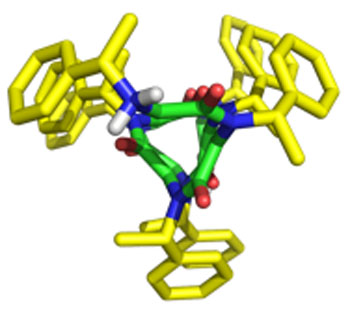Peptoids that Mimic Antigen Shapes May Lead to a New Generation of Diagnostic Tests
By LabMedica International staff writers
Posted on 22 Jun 2016
A novel immunoassay for detection of HIV is based on anti-HIV antibodies that recognize specific three-dimensional shapes in a massive, randomly generated library of synthetic peptoid molecules.Posted on 22 Jun 2016
Investigators at the University of Pittsburgh School of Medicine (PA, USA) hypothesized that a random combinatorial library of synthetic poly-N-substituted glycine oligomers, or peptoids, could represent a random "shape library" in antigen space.

Image: The molecular structure of a peptoid helix (Photo courtesy of The Peptoid Summit).
To test this theory, the investigators synthesized and screened a "one bead one compound" combinatorial library of peptoids, in which each bead displayed an eight-mer (repeating unit) peptoid with ten possible different amines at each position (108 theoretical variants). By screening one million peptoid beads the investigators found 112 (approximately one in 10,000) that preferentially bound immunoglobulins from human sera known to be positive for anti-HIV antibodies. Reactive peptoids were re-synthesized and rigorously evaluated in plate-based ELISA-style tests.
Results published in the May 12, 2016, online edition of the Journal of Immunological Methods revealed that four peptoids showed very good, and one showed excellent, properties for establishing a sero-diagnosis of HIV. These results demonstrated the feasibility of constructing sero-diagnostic assays for infectious diseases from libraries of random molecular shapes.
"This "needle-in-a-molecular haystack" approach is a new way to develop diagnostic assays," said senior author Dr. Donald S. Burke, director of the Center for Vaccine Research at the University of Pittsburgh School of Medicine. "The method does not rely on starting with known viral components. This is important because there are conditions for which there is not a known antigen, such as newly emerged epidemics, autoimmune diseases or even responses to traumatic injury."
"This technology means that we may be able to take a single drop of blood from a patient and detect antibodies to all manner of infections, cancers or other conditions they may be carrying or been exposed to," said Dr. Burke. "We hope that this is the first step toward development of an "Epi-chip" that can be used to reconstruct a person's entire exposure history."
Related Links:
University of Pittsburgh School of Medicine













